iPhone 13 Pro vs MacBook Pro: A Comprehensive Analysis
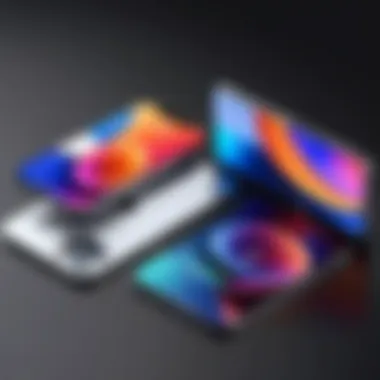
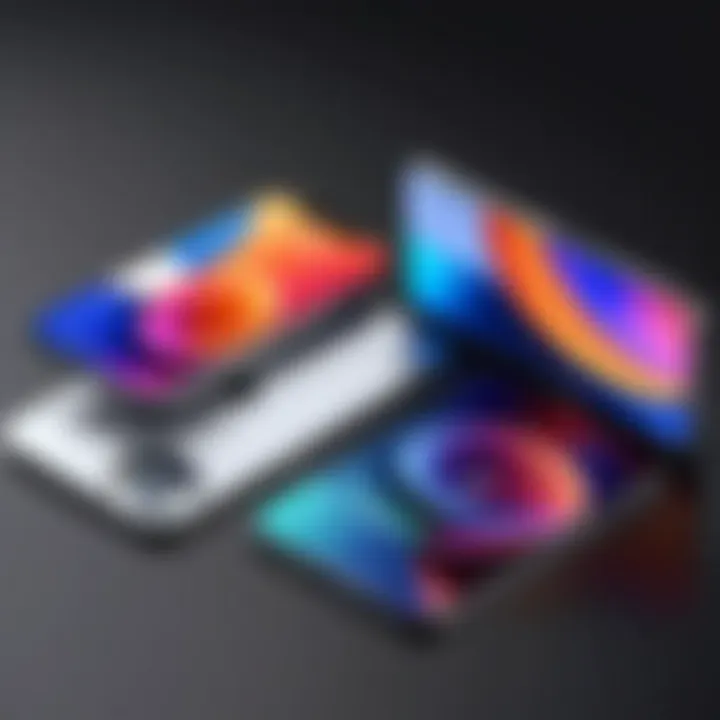
Intro
In today's rapidly evolving tech landscape, the distinction between devices often becomes blurred. The iPhone 13 Pro and the MacBook Pro represent two flagship products from Apple that appeal to different segments of consumers. Each device showcases advanced technology tailored for specific use cases, yet both share a commitment to high performance and user experience. This section will establish the foundation for a comprehensive exploration that follows, allowing potential buyers to make informed decisions based on their technology needs.
Overview of the Technology
Key specifications
The iPhone 13 Pro is equipped with Apple's A15 Bionic chip, which not only promises exceptional processing power but also enhances the efficiency of graphics rendering. The device sports a 6.1-inch Super Retina XDR display, delivering vivid colors and sharp detail suitable for both media consumption and professional tasks. Meanwhile, the MacBook Pro features Apple's M1 Pro or M1 Max chip, designed for heavy-duty tasks like video editing and programming. The display is larger, at 14 or 16 inches, boasting a Liquid Retina XDR screen that pushes boundaries in brightness and contrast.
Both devices come with varying storage options. The iPhone 13 Pro offers up to 1TB of storage, while the MacBook Pro can be configured up to 8TB, catering to more intensive storage demands of creative professionals.
Unique selling points
For the iPhone 13 Pro, key selling points include its exceptional camera capabilities, featuring a triple-lens system that excels in low-light conditions and offers advanced computational photography features. Battery life stands out too, with up to 22 hours of talk time.
Conversely, the MacBook Pro shines through its enhanced keyboard and larger trackpad, making it comfortable for prolonged use, and its Thunderbolt 4 ports allow for versatile connectivity options. The high refresh rate of the display, combined with ProMotion technology, also makes it an attractive option for professionals in the visual arts.
Design and Build Quality
Material used
Apple is known for its meticulous attention to detail in terms of design. The iPhone 13 Pro is made of surgical-grade stainless steel, providing both durability and a luxurious feel. It also features Ceramic Shield glass, which enhances the device's resistance to drops and scratches. On the other hand, the MacBook Pro utilizes aluminum chassis, which not only contributes to its lightweight nature but also enhances thermal management during demanding tasks.
Ergonomics and usability
When it comes to ergonomics, the iPhone 13 Pro is designed for ease of use, fitting comfortably in the hand, making one-handed operations feasible for most tasks. It balances weight and size well, catering to portability without sacrificing screen space.
In contrast, the MacBook Pro's design is geared towards providing a professional workspace. The keyboard is backlit and designed for comfort, ideal for long typing sessions. The larger screen size combined with a resolution optimized for productivity makes it less portable but more powerful for certain work environments.
This comparison highlights subtle yet crucial differences that can influence user experience significantly.
Preface to Product Categories
Understanding the differences between consumer technology products is essential for making informed purchasing decisions. Each product category serves distinct needs and comes with its own features and functionalities. In this case, we analyze two flagship offerings from Apple: the iPhone 13 Pro and the MacBook Pro.
These devices represent different approaches to mobile computing. The iPhone 13 Pro emphasizes portability and personal communication, while the MacBook Pro targets users who require a more robust computing solution. Recognizing these differences leads to better choices rooted in individual requirements.
When comparing products in a detailed manner, certain aspects warrant close attention.
- Design: The aesthetics and build quality of each device play a critical role in user experience.
- Performance: This includes speed, processing power, and overall capability to handle tasks efficiently.
- Usability: The ease of use is vital to determine how well a product integrates into daily life, impacting customer satisfaction.
Understanding these categories allows potential buyers to evaluate their needs more clearly, ensuring they select a device that aligns with their lifestyle and usage patterns. It also equips them with knowledge about the strengths and weaknesses of each device, facilitating a more informed decision-making process. The insights gleaned from these discussions will ultimately guide consumers toward the product that best suits their technological needs.
Overview of the iPhone Pro
In the modern landscape of mobile technology, the iPhone 13 Pro stands as a pivotal device for Apple. This section aims to detail its specifications and features, contributing to an understanding of its significance within the broader context of consumer tech. The iPhone 13 Pro offers a combination of cutting-edge hardware and software that appeals to a wide array of users, from casual consumers to professionals needing powerful tools on-the-go.
Design and Build Quality
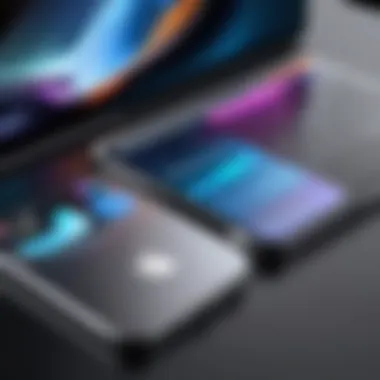
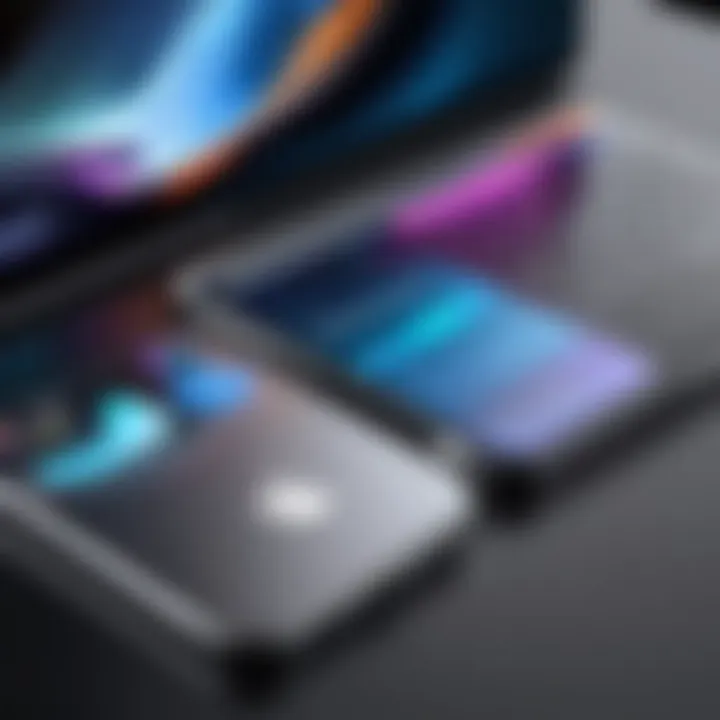
The design of the iPhone 13 Pro reflects Apple's commitment to aesthetics and functionality. Its surgical-grade stainless steel frame gives a sense of luxury, complemented by the Ceramic Shield front that provides enhanced durability. The device is available in various colors, allowing users to express personal style. The tactile experience is noteworthy, with a sleek body that fits comfortably in hand.
Notably, its size and weight contribute to portability. At 6.1 inches, the display balances screen real estate with usability. In a fast-paced world, this portability makes it easy to carry, blending seamlessly into daily life.
Performance Specifications
Underneath the beautiful surface, the iPhone 13 Pro is powered by the A15 Bionic chip. This processor is notable for its speed and efficiency, boasting six CPU cores and a unified memory architecture. The result is responsive performance, whether running apps, gaming, or multitasking across different applications.
With up to 1TB of storage options available, there is flexibility for users needing space for apps, photos, and videos. Furthermore, the integration of 5G technology enhances connectivity speeds, allowing for an upgraded user experience.
Camera Capabilities
Photography on the iPhone 13 Pro reaches new heights with its advanced camera system. Equipped with a triple-camera array, including a wide, ultra-wide, and telephoto lens, it offers versatility for various shooting scenarios. Night mode enhances low-light captures, while Photographic Styles provide users with customizable camera settings for personalized results.
Video capabilities are equally impressive. The ProRes video recording feature allows users to shoot professional-quality footage directly from their phone. This is appealing for content creators who rely on high-quality visual output.
Battery Life and Efficiency
Battery life is another strong aspect of the iPhone 13 Pro. Users can expect more than a day of usage with regular tasks, thanks to the efficient A15 chip and software optimizations in iOS. The phone's power management is effective, granting users confidence in its performance throughout the day without frequent recharging. With 20W fast charging, users can also quickly recharge when necessary, promoting convenience in busy lifestyles.
Software Integration
The iPhone 13 Pro operates on iOS, which is known for its fluidity and security. The integration between the hardware and software ensures a smooth experience. Custom features like Focus mode enhance productivity by allowing users to manage notifications and reduce distractions effectively.
Additionally, Apple's ecosystem plays a crucial role. The seamless interaction between the iPhone and other devices, such as the MacBook Pro and iPad, enhances workflow for users who may switch between devices throughout the day. This synergy makes the iPhone 13 Pro attractive for individuals heavily invested in Apple's ecosystem.
Overview of the MacBook Pro
The MacBook Pro represents a pinnacle of Apple's laptop design and performance. It is a cornerstone for professionals and creatives alike, combining robust features with a sleek aesthetic. Understanding the MacBook Pro's nuances is essential, especially when comparing it to the iPhone 13 Pro, which is more of a mobile device. The MacBook Pro excels in various key aspects including ergonomics, processing power, and user experience, making it a vital topic in this analysis.
Design and Build Quality
The design of the MacBook Pro is a study in form and function. Available in varied sizes, it features a sturdy aluminum chassis that is both lightweight and durable. The precision engineering that goes into the MacBook Pro creates a device that feels premium. The edges are smoothly rounded, and there is a subtle elegance to its appearance. The Retina display, which boasts high resolution, is a key highlight. This not only enhances the visual experience but also reflects Apple's commitment to quality. The layout of the ports and ability to connect to peripherals also factor into the overall utility of the device.
Performance Specifications
Performance is where the MacBook Pro truly shines. Equipped with Apple’s M1 Pro or M1 Max chip, depending on the model, the MacBook Pro offers remarkable processing capabilities. This enables seamless multitasking, even when handling complex applications. The variants of RAM and storage also allow users to customize their machine to fit their needs. Specialized tasks such as video editing or software development can be managed with ease, positioning the MacBook Pro as a real contender in the professional space.
Display Features
The display on the MacBook Pro is not just about high resolution; it's about the experience. The liquid Retina XDR technology enhances brightness and contrast, allowing for a more vibrant visual output. This is particularly beneficial when working with color-critical projects like graphic design or photography. The larger screen size compared to the iPhone 13 Pro provides more workspace, which is a significant advantage for professionals who need to view multiple applications simultaneously.
Keyboard and Trackpad Experience
User experience on the MacBook Pro is further enhanced by its keyboard and trackpad. The Magic Keyboard offers a responsive feel. The travel distance of the keys is well-calibrated, which aids in reducing typing fatigue. Furthermore, the large trackpad is incredibly smooth and responsive, supporting a variety of gestures that enhance productivity. This combination allows for an enjoyable typing experience, which is vital for heavy users who require efficiency in their workflow.
Software Ecosystem
Finally, the MacBook Pro operates within a cohesive software ecosystem. macOS provides a platform that allows seamless integration with other Apple devices, such as the iPhone 13 Pro. This ensures that users can switch between devices without losing functionality. Many professionals rely on software such as Final Cut Pro, Logic Pro, and various creative tools that run exceptionally well on this hardware. The continuity and compatibility of software enhance the overall value of the MacBook Pro for its target demographic.
Key Differences in Performance
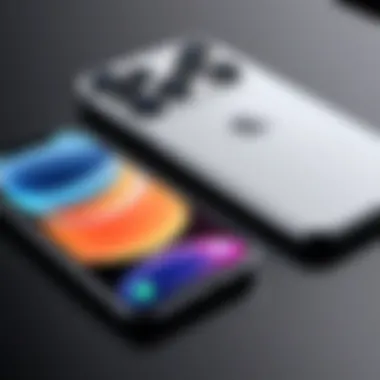
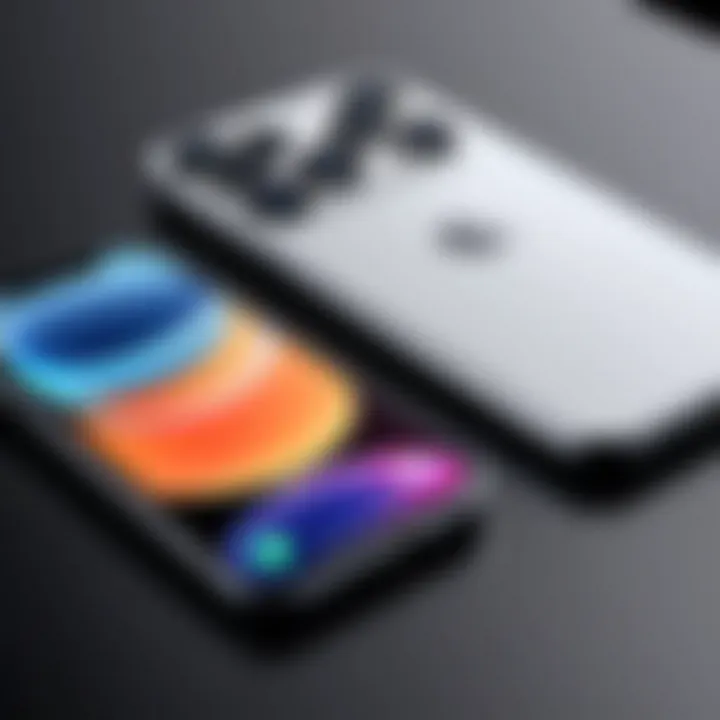
In this section, we delve into the nuances that define the performance of the iPhone 13 Pro and the MacBook Pro. Understanding these differences is critical for potential buyers. The scope of performance encompasses the efficiency of processors, graphics capabilities, and multitasking efficiency. Each factor plays a pivotal role in how effectively these devices can execute various tasks, thereby influencing user experience and satisfaction.
Processor Capabilities
The heart of any computing device is its processor. The iPhone 13 Pro employs the A15 Bionic chip, which is renowned for its speed and computational efficiency. This chip features a 6-core CPU, which comprises two performance cores and four efficiency cores. Such design allows for swift multitasking while optimizing battery life. Users engaged in graphic-intensive applications or gaming can benefit greatly from this chip's capabilities.
In contrast, the MacBook Pro is powered by Apple's M1 Pro or M1 Max chips, depending on the model. These chips offer remarkable performance with more cores in both CPU and GPU. While the M1 Pro features up to 10 CPU cores and 16 GPU cores, the M1 Max can house up to 10 CPU cores and a staggering 32 GPU cores. This difference in processor architecture results in enhanced performance, particularly for professional-grade applications, such as video editing and 3D rendering.
Graphics Performance
Graphics performance is another area that sets these devices apart. The iPhone 13 Pro’s A15 chip includes a 4-core GPU that delivers impressive graphics rendering for mobile gaming and high-resolution video playback. The seamlessness with which it handles demanding apps can be attributed to Apple's optimization of software and hardware. For mobile users, this means superior experiences while playing demanding games or using visually intensive applications.
On the other hand, the MacBook Pro’s graphics capabilities significantly surpass those of the iPhone 13 Pro. The M1 Pro and M1 Max chips incorporate advanced graphics processing units that are specifically designed for demanding workloads. Creative professionals will find that the MacBook Pro is adept at handling high-performance tasks like 3D graphics rendering or video effects. The sheer volume of GPU cores allows it to render complex scenes without dropping frame rates, making it ideal for professional needs.
Multitasking and Usability
When considering multitasking, the iPhone 13 Pro shines in mobile scenarios. Users can easily switch between applications, thanks to the efficient management of resources by its A15 chip. Features like Picture in Picture and split-screen make multitasking on a mobile device feasible. For someone primarily using their phone for communication and light productivity, this level of performance is adequate.
Conversely, the MacBook Pro is built for advanced multitasking. With its more robust architecture, users can run multiple professional-grade applications smoothly. The operating system, macOS, is highly optimized for multitasking, allowing users to arrange their workspace according to needs. This enables seamless transitions between various tasks and significantly boosts productivity, especially for users handling intensive workflows.
"Users looking for an efficient multitasking tool will find that the MacBook Pro outperforms the iPhone 13 Pro by a wide margin, particularly in professional environments."
In summary, while the iPhone 13 Pro provides adequate performance for mobile users, the MacBook Pro stands out with superior processing power and graphics capabilities, making it a robust choice for professional applications. Understanding these distinctions allows potential buyers to match their device to their requirements effectively.
Communications and Connectivity
In today's digital world, communications and connectivity have become essential aspects of consumer technology. For potential buyers evaluating the iPhone 13 Pro and the MacBook Pro, understanding the capabilities of each device in this area is crucial. Both devices serve different communication needs yet complement each other in usability and functionality.
Wireless Technology
The iPhone 13 Pro and MacBook Pro offer advanced wireless technologies, which facilitate seamless internet access and device interoperability. The iPhone 13 Pro supports 5G connectivity, providing faster download and streaming speeds. This advancement minimizes latency, making it ideal for users engaged in high-bandwidth activities, such as video conferencing or gaming.
On the other hand, the MacBook Pro includes Wi-Fi 6 capability, ensuring improved network efficiency and lower latency when connected to compatible routers. This combination enables users to maintain stable connections across devices, whether at home or in public spaces such as cafes. Additionally, both devices support Bluetooth technology, allowing for easy pairing with accessories such as headphones and smartwatches.
Peripheral Compatibility
The compatibility of peripherals is an often-overlooked aspect of communications. The iPhone 13 Pro offers tools like AirDrop and Handoff, which allow users to share files effortlessly among Apple devices. This is particularly useful for creative professionals who rely on frequent file transfers between their iPhone and MacBook.
Conversely, the MacBook Pro is outfitted with multiple Thunderbolt and USB-C ports. This connectivity allows users to connect various peripherals, such as external monitors, storage drives, and specialized devices without any hassle. In combination, these features enhance user experience, providing flexibility in interaction across devices that can streamline workflows and increase productivity.
"Understanding the nuances of connectivity between devices offers deeper insight into how technology can enhance daily tasks."
Target Audience Analysis
Understanding the target audience for both the iPhone 13 Pro and the MacBook Pro is essential in discerning their respective roles in the consumer technology landscape. This section aims to identify who would benefit most from these devices, considering their distinct features, capabilities, and pricing structures. Knowing the target audience helps potential buyers make informed decisions based on their individual needs and use-cases rather than merely aesthetic preferences. Efficiency, compatibility, and usability are crucial points in this analysis.
Who Should Choose the iPhone Pro
The iPhone 13 Pro is tailored for those who prioritize mobility paired with high-performance functionalities. Professionals who require a reliable smartphone for communication, media consumption, and app usage might find the iPhone 13 Pro to be an optimal choice. It is favored by users who are engaged in photography and videography, as its camera system is superior and supports advanced features such as ProRAW and Night mode.
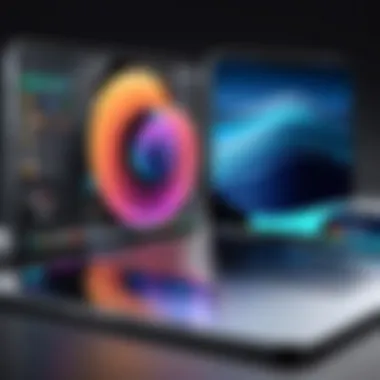

Key benefits of choosing the iPhone Pro include:
- Excellent camera performance with advanced software integration.
- Seamless synchronization with other Apple products, enhancing usability.
- Compact and lightweight design, making it easy to carry.
- Strong focus on security, with features like Face ID.
For tech enthusiasts and early adopters, the iPhone 13 Pro also offers cutting-edge technology like 5G compatibility and the A15 Bionic chip, making it suitable for high-demand applications and mobile gaming.
Who Should Choose the MacBook Pro
The MacBook Pro caters to a different demographic, targeting professionals who require a powerful computing solution. This device is ideal for individuals in creative fields such as graphic design, video editing, and software development. Given its robust processing power and large display, the MacBook Pro enhances productivity in multitasking environments.
Who might find the MacBook Pro appealing?
- Users who need a high-performance laptop with superior graphics capabilities.
- Professionals who work extensively with software that demands significant processing power.
- Those looking for a device that supports a high degree of customization through apps and extensions.
Its well-designed keyboard and large trackpad enhance the user experience further, making it a practical choice for those who engage in extensive writing or coding. Users would appreciate the impressive display quality and software ecosystem that seamlessly integrates with their workflow.
Understanding the unique audiences for the iPhone 13 Pro and MacBook Pro assists in recognizing how both devices serve different, yet equally significant, roles in today’s technological environment.
Pricing and Value Proposition
Pricing and value proposition are crucial factors when evaluating consumer electronics like the iPhone 13 Pro and the MacBook Pro. These elements help customers understand what they are getting versus what they pay. It's essential to analyze how each product fits into the broader marketplace, especially given the premium price point associated with these Apple devices. By shedding light on the cost, buyers can make informed choices that align with their budgets and needs.
Cost Comparison
When comparing the costs of the iPhone 13 Pro and the MacBook Pro, it's imperative to consider the models and configurations available. The price for the iPhone 13 Pro varies based on storage capacity. Typically, it ranges from around $999 for the base model to over $1,099 for models with higher storage options. The MacBook Pro, on the other hand, has a starting price around $1,299, with higher configurations—especially those with additional features like more RAM or storage—pushing it to $2,499 or beyond.
Important Note: Keep in mind that prices can fluctuate based on promotions or retailer discounts.
Several factors can justify these price points:
- Build Quality: Both devices are known for their solid construction and premium materials.
- Brand Value: Apple has a reputation for quality and consistent performance, which often comes with a higher initial investment.
- Features: The iPhone 13 Pro boasts features like advanced camera systems and 5G capability. In contrast, the MacBook Pro excels in multitasking and professional-grade applications.
Ultimately, consumers must determine what features are critical to them and how much they are willing to spend to obtain those advantages.
Long-Term Investment Considerations
When analyzing long-term investment, it is crucial to take into account not only the initial cost but also the depreciation and resale value of each device. Apple's products typically retain a significant portion of their value over time compared to competitors. For instance, if one decides to sell an iPhone 13 Pro after a year or two, its resale price might still be competitive due to its persistent demand and robust brand loyalty.
Similarly, the MacBook Pro, known for its performance longevity, may allure those who consider not just present usage but future needs as well. Professionals often prefer investing in MacBooks due to their lifespan and ability to run demanding software efficiently. This durability can translate to lower total cost of ownership over time.
Moreover, consider:
- Software Updates: Apple provides regular updates for both devices, ensuring that users benefit from security enhancements and new features, which can prolong their life cycle.
- Warranty and Support: Apple’s customer service and support may justify the additional cost. The extended warranty options provide peace of mind for users.
Closure and Recommendations
The conclusion of an in-depth comparison between the iPhone 13 Pro and the MacBook Pro serves a critical role in guiding potential buyers. Understanding the distinct features and capabilities of each device is essential for making an informed choice. Consumers must weigh their unique needs against the specifications presented in the earlier sections.
One important element to consider is how each device aligns with specific user requirements. For example, the iPhone 13 Pro offers advanced mobile photography capabilities and superior portability. Individuals who prioritize communication and on-the-go usability may find this smartphone more suited to their lifestyle. Conversely, the MacBook Pro excels in providing a powerful computing experience, making it ideal for professionals who engage in tasks such as graphic design, video editing, or software development.
Several recommendations can be made based on the analysis:
- Evaluate Priorities: Determine what features are most vital. Is it display quality, performance, or perhaps battery longevity?
- Assess Usage Scenarios: Think about how you will utilize the device. For heavy multitasking, the MacBook Pro's capabilities might be preferable.
- Long-Term Value: Consider the investment aspect. Both devices are expensive, but their longevity and resale value may differ. Research should include market trends to ensure a sound decision.
- Cross-Device Synergy: If you already own other Apple devices, consider how well these products work together. Their ecosystem allows seamless integration that can enhance usability.
"Selecting technology is not just about the price; it's about the experience and how it fits into one's life."
Ultimately, both the iPhone 13 Pro and the MacBook Pro present strong value propositions, albeit for different audience segments. The right choice will inherently vary by individual needs and preferences. Therefore, potential buyers should reflect on their habits and requirements when selecting between the iPhone 13 Pro and the MacBook Pro.







